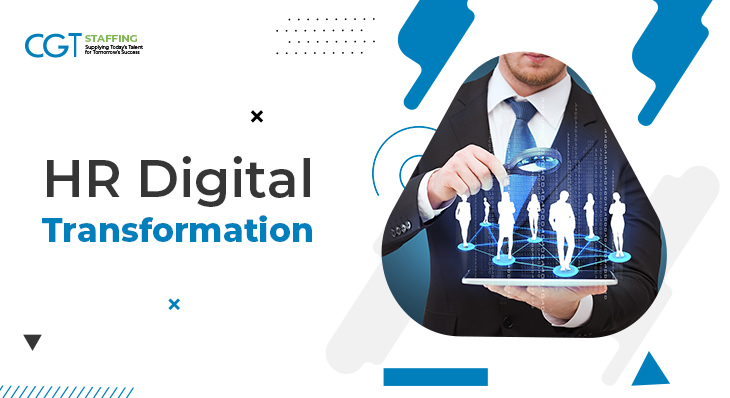As the business landscape continues to evolve, organizations are on a relentless quest to streamline their operations and maintain a competitive edge. HR digital transformation has been at the heart of all this disruption and has revolutionized workforce management. Moreover, it has made the entire employee experience seamless, enabling staffing partners to onboard new hires at their clients’ organizations with ease.
Table of Contents
An Overview of HR Digital Transformation
Using advanced technologies and tools, routine tasks can be automated with the benefit of digital transformation. Data analytics can be incorporated into decision-making processes to make performance management and employee self-service more systematic; likewise, to make partnership with a staffing firm to manage recruiting and onboarding more seamless. The primary goal is to reduce administrative burdens and enhance the overall employee experience.
According to a digital transformation case study, organizations are embracing cutting-edge technologies and transitioning to cloud-based HR management systems. This shift enables self-service portals for employees, empowering them to make necessary updates, reducing overhead costs, and increasing employee engagement. Data analytics tools play a crucial role in gathering insights for talent acquisition, performance management, and employee satisfaction.
Digital Transformation Strategies for HR
HR strategies are centered around maximizing efficiency through technology, data analytics, and refinement. The implementation of these strategies mitigates risks and fosters a culture of continuous growth. Let’s explore some key benefits of HR digital transformation:
Streamlined Recruitment and Onboarding
Recruitment and onboarding can be cumbersome and costly for any organization. Partnership with a staffing partner, in order to eliminate the time drain caused by these, is often a worthy investment. For staffing firms, the HR digital transformation has streamlined the process by easing the lengthy identification of talent pools and simplifying the screening and filtering of job applicants. Modern Applicant Tracking Systems (ATS) provide for all of these functions on a single platform. This system enables the firm to identify passive candidates, delivering a more effective talent acquisition strategy for clients.
Enhanced Efficiency and Productivity
The primary objective is to enhance processes while lowering costs. Tasks like data entry and paper document storage are time-consuming and prone to errors. Digital tools enable organizations to automate these processes, significantly improving efficiency and reducing the margin for mistakes.
Increase Employee Self-Service
HR digital transformation doesn’t merely revamp HR processes; it extends to benefit employees as well. Self-service portals and applications grant employees access to HR information, allowing them to apply for leave, check payrolls, or update their records with ease. This self-reliance empowers HR to focus on more critical tasks, enhancing employee satisfaction.
Encourages Data-Driven Decision Making
The collection of data has never been more straightforward. Whether it’s performance metrics, engagement data, or other HR-related information, digital transformation has simplified data collection and analysis. Portals equipped with AI models automatically filter and analyze relevant data, which can be collected through surveys or similar means. This data is crucial for aligning the organization with its goals, particularly in the case of direct hire recruiting.
Compliance and Risk Management
Adhering to laws and regulations is paramount for organizations, as non-compliance can result in serious penalties. HR digital transformation plays a proactive role in monitoring all organizational activities to ensure policies are correctly followed.
Remote Work and Flexibility
The rise of remote work is partly attributed to HR digital transformation. It allows employees to stay connected while working from home, promoting such cost-saving measures as downsizing the organization’s real estate footprint and reducing maintenance expenses.
Enhanced Employee Engagement
HR digital transformation fosters greater employee engagement by providing self-service portals and tools that empower employees to take control of their HR-related tasks. This autonomy improves the overall employee experience and satisfaction, leading to a more motivated and loyal workforce.
Data-Driven Recruitment
By harnessing data analytics, HR teams can make more informed recruitment decisions. They can identify the best sources for talent acquisition, understand which candidates are the best fit for the organization, and tailor recruitment strategies accordingly.
Predictive Analytics
HR digital transformation allows organizations to employ predictive analytics to forecast employee turnover and identify potential issues within the workforce. This foresight enables proactive measures to retain top talent and address concerns before they escalate.
Global Collaboration
Digital tools and cloud-based HR systems enable organizations to streamline HR processes across multiple locations and global offices. This fosters collaboration and consistency in HR practices, even in multinational corporations.
Enhanced Training and Development
Digital platforms facilitate online training and development programs, allowing employees to access resources and courses at their convenience. This not only promotes continuous learning but also empowers employees to take charge of their professional growth.
In summary, HR digital transformation is a powerful tool with the potential to empower employees and enhance the overall functioning of organizations. It is a key driver of both financial success and strategic growth, and it continues to shape the modern landscape of HR practices, making them more efficient, effective, and employee centric. The journey toward a digitally transformed HR is not just about keeping up with the times; it’s about staying ahead of the curve.
